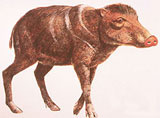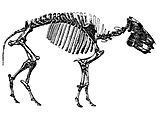Peccary

In 1938, one of the scientists who excavated at the Hagerman Horse Quarry, Dr. C.L. Gazin, described a new species of peccary, Platygonus pearcei, from the Hagerman fossil beds. The name Platygonus means flat head and refers to the straight shape of the forehead. The species name pearcei is for the discoverer, George B. Pearce, a member of the 1934 Smithsonian field crew. Since its original discovery at Hagerman, Pearce's peccary has been found near Grand View Idaho and at White Bluffs, Washington.

People often confuse peccaries, which are found in the New World, with pigs which originated in the Old World, especially since some domestic pigs brought by european settlers have escaped over the years and now run wild in many parts of the United States. These feral pigs are popularly known as razor-back hogs. Relatives of the Old World pigs include the wart hog of Africa. One of the ways to tell the two groups apart is the shape of the canine tooth or "tusk". In the Old World pigs the tusk is long and curves around on itself, whereas in the New World peccaries the tusk is short and straight. Peccaries are plant eaters and use it for defense. By rubbing the tusks together they can make a chattering noise that warns potential predators to not get too close.
Today there are three living species of peccary. They are found from the southwestern United States through Central America and into South America. The only peccary in the United States is the collared peccary (Dicotyles tajacu), also known by its spanish name, javelina. It is often found in dry arid habitats. A second species is the White-lipped peccary (Tyassu peccari) which is found in the rain forests of Central and South America. The last species, the Chacoan peccary (Catagonus wagneri) is the closest living relative to the extinct Platygonus pearcei found at Hagerman. It is found in the dry shrub habitat or Chaco of Paraguay, Bolivia and Southern Brazil. The Chacoan peccary has the unusual distinction of having been first been described based on fossils and was originally thought to be only an extinct species. In 1975 the animal was discovered to still be alive and well in the Chaco region of Paraguay. This third species of peccary was well known by the native indians but it took awhile for scientists to discover its existence.

Peccaries have a long history in North America. They first appear in the Early Oligocene, about 32 million years ago and a variety of different species are present in faunas of different ages across the continent. Some of these extinct peccaries have been found at John Day Fossil Beds National Monument in Oregon and at Badlands National Monument in South Dakota. Although common in South America today, peccaries did not reach that continent until about 9 million years ago. Prior to that, there was no isthmus of Panama, and South America was an island continent. As the Panamanian isthmus formed, many North American animals entered South America. Along with peccaries, lames and tapirs also migrated south. Today people think these animals are South American, yet all come from North American ancestors. The exchange was a two-way street however, and some of the ancient South American species, like the ground sloth, migrated north and are found at Hagerman.
Modern peccaries are social animals and often form herds. Over 100 individuals have been recorded for a single herd of white-lipped peccary but smaller size groups are usually the case in the collared peccary and Chacoan peccary. Such social behavior seems to have been the situation in extinct peccaries as well. Pearce's Platygonus discovery at Hagerman included 3 individuals, an adult and two juveniles. The skeletons were found articulated (all of the bones in proper position to each other) suggesting that this small family group died at the same time and were quickly buried.
The entire family group was preserved as one piece and is on display at the Smithsonian in front of the Hagerman mural. That Pearce's peccary must have been a common member of the Hagerman fauna 3.5 million years ago is also indicated by the numerous isolated bones and teeth that have been found throughout the Monument.